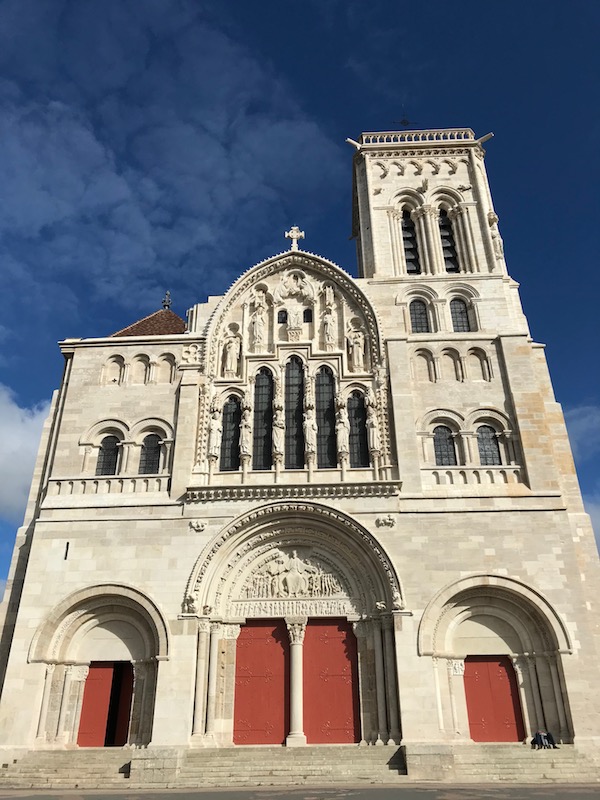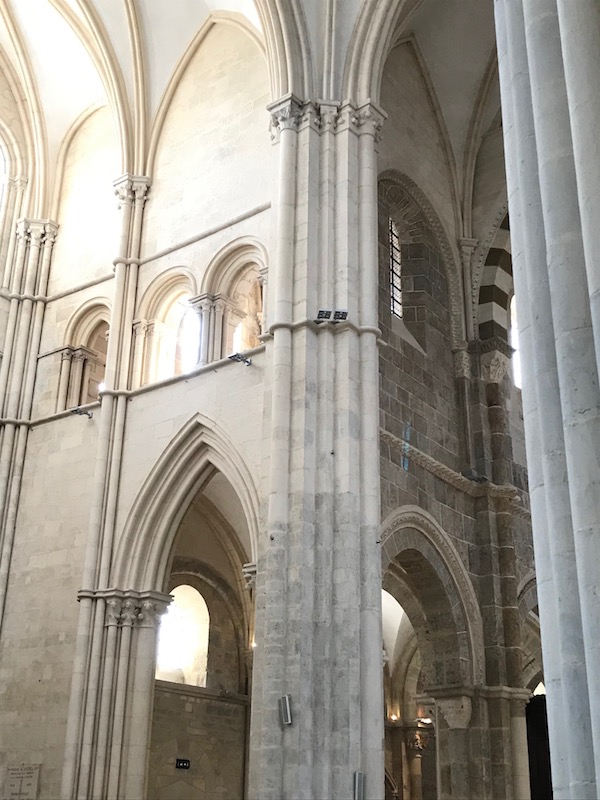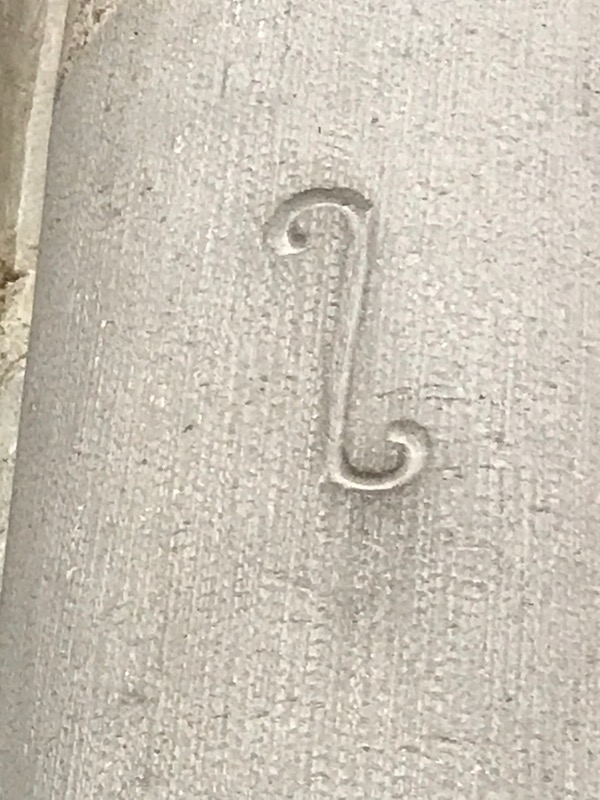Our Blog - Vézelay, France
The first traces of human settlement in the vicinity of Vézelay date from 2300–2200 BC. The Romans set up wine-growing on the hill of Vézelay in the 1st century. A temple in honor of Bacchus was discovered by a parish priest in 1689 in the foundations of the old church of Saint-Etienne during the construction of a new bell tower. In the 9th century the Benedictines built a monastery and the relics of Mary Magdalene were brought to Vézelay. This made it a pilgrimage site and it is the starting point of one of the main pilgrimage routes of Saint-Jacques-de-Compostelle.
The Basilica of Sainte-Marie-Madeleine de Vézelay was founded in the AD 880 on a former Roman and Carolingian site, Vézelay's stunning hilltop basilica was rebuilt between the 11th and 13th centuries. On the famous 12th-century tympanum, visible from the narthex (enclosed porch), Romanesque carvings show an enthroned Jesus radiating his holy spirit to the Apostles. The nave has typically Romanesque round arches and detailed capitals, while the transept and choir (1185) have Gothic ogival arches. The mid-12th-century crypt houses a reliquary reputedly containing one of Mary Magdalene's bones.
The Benedictine monks settled at the top of the hill of Vézelay and the first church was dedicated in 878. The crypt from that church remains today. A new church was started in 1096 and the construction lasted until around 1217 ... going through various ups-and-downs during that time. It was damaged during the wars of religion and due to a couple fires. The town looked to restore it, and after most well-known architects declined to join the project, a young architect named Eugene Eugène Viollet-le-Duc signed on in 1840. If the name sounds familiar, it should ... He was one of the most famous French architects of the 19th century, known to the general public for his restorations of castles, medieval, and religious buildings.
On the Western façade, there are three doors with the central portal having a carved tympanum. You can see one tower, the Saint-Michel tower, although two were actually planned. This one was built, in Gothic style, in the 14th century. Above the central portal is a large gable. It is really hard to see the upper part of this, but the lower part has 5 tall windows that allow light into the narthex and 6 large statues representing Saint John the Evangelist, Saint Andrew, John the Baptist, Saint Peter, Saint Paul, and Saint Benedict. The tympanum is impressive, and you should take a good look at this one, as you will need to compare it to another one later in the blog. The scene is that of the Last Judgement and was sculpted in 1856 in the neo-Romanesque style. In the center, Christ presides over the scene, both arms wide open. At his feet, on his left, the Archangel Saint Michael , a hideous devil at his side, weighs souls. The damned, usually naked, head for hell and are swallowed by the mouth of a monstrous Leviathan. At the right hand of Christ, the elect are led to heavenly Jerusalem.




We started out taking a guided tour (in French), which told a lot of the history and discussed the Narthex, the front-nave or vestibule. The narthex is one of the great constructions of the Romanesque period. It is a piece that was essential to allow the formation of processions in the nave. Two stories tall, if you look closely you can see an architectural difference in the ground floor arches and the 1st floor arches ... the vaults are different as they ended up being built 10 years later.


The tympanum of the central portal, or large tympanum of the narthex, is one of the greatest masterpieces of Romanesque sculptural art in France. It represents the historic creation of the Church, with Christ blessing the apostles and assigning them the mission of converting the nations. This theme is quite unique in Romanesque art. You can see how the statue of Christ dominates the other characters in size but this is proportional to the importance of the characters represented. The guide took a long time discussing this tympanum, specifically comparing Christ on this one to the exterior one. Scroll back up and compare the legs and movement of the garments. You can see how this one, Romanesque style, seems to be more "in motion" and moving compared to the more rigid neo-Romanesque style Christ on the exterior tympanum. These are in great shape because they were shielded from the weather and also were protected during the French Revolution, when the outside statues were destroyed and then redone in the 19th century. As you look at the details, remember that these were done in the 1100's.



The tympanum over one of the smaller doors, dating from 1120-1140. This one shows scenes from Christ's childhood according to the accounts of the Gospels of Matthew and Luke.

The nave is lighter than the narthex and it seems very very long. In fact, it is ... it is longer than great French cathedrals like Notre-Dame de Paris or Notre-Dame d'Amiens. Completed in 1140, it is Romanesque in style. You can see the two-tone arches the entire length of the nave. These are very Romanesque, simple rounded arches (compared to Gothic ribbed vaults that we have seen in other churches).


We've made our way up to the choir, and here you can see the style change to Gothic (see the pointed arches). This was built at the end of the 12th century as the style was transitioning from Romanesque to early Gothic. Not only are the tops of the arches pointed, but you can see how the vaults in the ceiling become narrower and are ribbed.


Some of the furnishings ... the choir stalls as well as what I assume is an old fresco that has been found during renovations (I can't find any details) and the carved wooden pulpit.




A quick trip down into the crypt, which dates from the 11th century. You can also see the case that contains the relics of Mary Magdalene, for whom the Basilica is named.



Stone cutter marks on some of the walls ... these are quite common in buildings from the Middle Ages. The stone masons would put a mark on each stone so that they could get paid for their work.



I can't say that I am a wine connoisseur, but I've had my fair share of tea. Mostly black tea, but a few green teas, a couple white teas, and even the red rooibos tea. But this was my first time ever tasting (or seeing, for that matter), blue tea. Blue tea, or butterfly pea flower tea, is a caffeine-free herbal tea made from leaves of the Clitoria ternatea plant. It is caffeine-free and it is packed with antioxidants. The tea is popular in Thailand and Vietnam, where it is served post dinner, usually with lemon and honey added to it. Adding lime or lemon juice to the tea changes the pH of the drink, making it change color from deep blue to purple.

